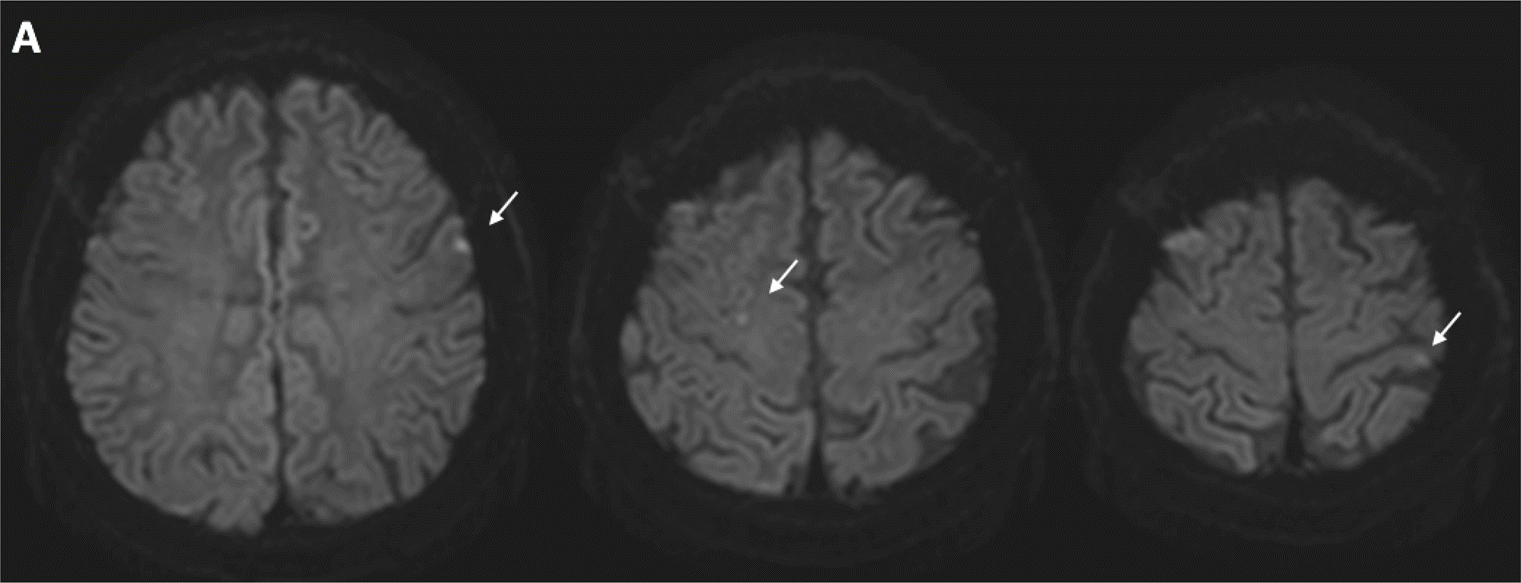Introduction
Increased risk of ischemic stroke in patients with atrial fibrillation (AF) emphasizes the importance of anticoagulation therapy for stroke prevention.1 Left atrial appendage (LAA) closure is considered an alternative to warfarin in patients with higher bleeding risk. LAA closure with the WATCHMAN device reportedly has a high successful implantation rate with low periprocedural risk of complications,2 and long-term safety comparable to that of warfarin.3,4 However, long-term clinical outcome data in real-world practice are still limited.5 The time to complete endothelial coverage of the device surface has not been clearly documented in humans.6 Herein, we describe a long-term complication after LAA closure, with delayed perforation of the WATCHMAN fabric membrane and associated stroke at 7 months after the procedure. The device shunt showed delayed disappearance after 15 months.
Case
A 69-year-old man with a history of hypertension, congestive heart failure, and persistent AF (CHA2 DS2-VASc score 3) was admitted. Because of a previous history of gastric bleeding during oral anticoagulation with warfarin, LAA closure was considered. A 27-mm WATCHMAN (Boston Scientific, Plymouth, MA, USA) device was successfully implanted on the initial attempt without acute procedure-related complications. A transesophageal echocardiogram (TEE) immediately after implantation and 8 weeks later showed adequate positioning without evident peri-device leakage. After 8 weeks of postprocedure anticoagulation, warfarin was changed to dual antiplatelet therapy with aspirin and clopidogrel.
Seven months after LAA occlusion, the patient was admitted to the emergency room with sudden dysarthria, and was diagnosed with multiple embolic cerebral infarctions on brain magnetic resonance imaging (Figure 1A). The patient was in sinus rhythm on admission. Central contrast filling in the LAA device was observed on cardiac computed tomography (CT) (Figure 1B and 1C), and to-and-fro flow communication at the center of the device and multiple thrombi were visible on the TEE (Figure 2A and 2B, Movie 1). At this time, we reexamined the 8-week postprocedure TEE, and a faint central jet with inward flow to the LAA was suspected (Movie 2).
Figure 1.
Brain MRI after admission for dysarthria revealed multiple embolic infarctions in the left postcentral gyrus with diffuse old ischemic lesions (arrows).

Figure 2.
A and B. CT after stroke (reconstructed to show the WATCHMAN axis) shows central contrast filling of the device (arrow).

The patient recovered on apixaban without neurologic sequelae and was followed without further events. The central communicating flow disappeared and organized thrombus filling the inner space of the device was observed at 15 months after the procedure (Movie 3).
Discussion
The WATCHMAN device has established use for LAA closure, and is an alternative to chronic oral anticoagulation in patients with nonvalvular AF at high risk for thromboembolism and bleeding.7,8 The noninferiority of the WATCHMAN device to warfarin in ischemic stroke and major bleeding was shown in randomized controlled trials.3,7,8 A study of 1,004 patients with successful WATCHMAN implantation reported acute procedure-related complications in 2.8% within 7 days, and 7.9% had serious adverse events including major bleeding, pericardial effusion, vascular damage, procedural air embolism, device embolization, and peri-device leakage within 30 days after the procedure.2 However, delayed complications related to suspected device perforation have not yet been reported.
Figure 3.
A and B. TEE (at 75°) after admission for stroke. To-and-fro flow communication was observed at the center of the device.

The device comprises a nitinol frame and a fabric membrane. Although the device was implanted successfully in a single attempt, the thin fabric membrane could have been damaged by device manipulation or deployment. Alternatively, spontaneous restoration of sinus rhythm may have improved LAA contractility in this case; this might have unmasked a preexisting, unnoticed small defect on the device. Although the patient was in AF at 15 months of follow-up, the central communicating flow had disappeared. Therefore, delayed endothelialization should be considered in patients with contrast filling of the LAA on follow-up cardiac CT.6 If device-related thrombus formation or peri-device leakage is observed, extended anticoagulation may be considered.5,9 To determine the duration of anticoagulation, serial imaging should be performed until complete endothelialization of the device is likely.













